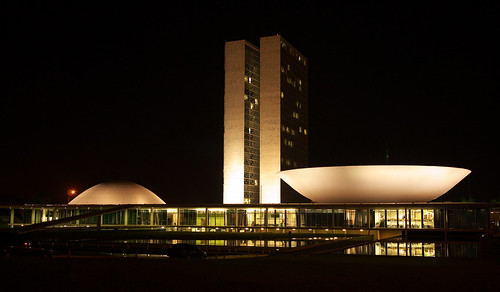
I arrived in Brasilia two days ago to check out the famous planned city. For those unfamiliar with Brasilia, it is famous for being a modernist city built only 50 years ago to become Brazils new capital. The city is in the central plains of Brazil, which was the middle of nowhere when the city was proposed (and still is, really).
The city was planned by Lucio Costa, with almost all of its iconic government buildings designed by Oscar Niemeyer. It's a sort of mecca of modernist planning and architecture, and as such is quite a unique city to visit. The main city plan (called the Pilot Plan (see this) looks like a bird or a plane from above, with one major axis (Eixo Monumental, which is 8 kilometers long) oriented East-West that houses the government buildings, hotel sectors and various monuments. Crossing the monumental axis are the two wings, which is where all the housing resides.
At the center, where the two axes cross is the main bus station for the city, along with a major shopping center. Being a city devised in the 50's when architectural modernism was at its peak, the city is heavily reliant on automobiles (the two main axes of the city are multi-lane highways). Automobile traffic is intense, while buses transport the majority of the population between the different sectors of the city. Every bus I saw and took was standing room only, whereas the central bus station was one of the busiest I've ever seen.
The major groundwork for the city was completed in just 3 years, which is insane and plunged Brazil into pretty serious debt. The original master plan foresaw a population of 500,000 people in the year 2000, but todays population is closer to 2.5 million. The two housing wings weren't planned to support such population growth, so satellite cities have blossomed around the Pilot Plan to support the working populations needed to run Brazil's capital.
Which is pretty unfortunate for the Pilot Plan, as the city was planned to be self-contained, so there weren't any proper provisions for how to deal with development outside of the main plan. Or maybe I'm wrong and urbanization outside of the Pilot Plan wasn't a concern as long as the purity of the core was maintained. I should ask Fares (the expert on Brasilia and one of my thesis advisors).
The Pilot Plan area of Brasilia is characterized by immense open spaces, which are filled in with prairie-like grasses and trees. Picture an African savannah with multi-lane highways and periodic white modernist buildings and you've got Brasilia.
Arriving in Brasilia by bus is confusing because whereby on a plane, you can clearly delineate the Pilot Plan and the Congresso Nacional, etc. When you arrive by bus, you come in from the periphery new cities, which are haphazard and less than charming. Buses from outside the city dump you at a run-down bus station at one end of the monumental axis, requiring a taxi or local city bus to bring you in. The reliance on the automobile is one of the worst aspects of Brasilia, in my opinion. Having a car here would be an altogether different experience (better).

No comments:
Post a Comment